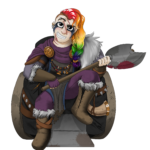The Cost of a D&D Wheelchair

By its use as a universal symbol of disability in the real world and its use throughout literature as the definitive representation of disability, it’s no wonder that, when people think of disability representation in TTRPG, wheelchairs roll into our minds immediately, so today (March 1) being International Wheelchair Day, let’s examine the role of wheelchairs in tabletop roleplaying games like Dungeons & Dragons.
Wheelchairs first appeared in Wizards of the Coast products with Banak Brawnanvil in the 2010 novel, Gauntlgrym and in fifth edition sources in Van Richten’s Guide to Ravenloft (2021) with Alanik Ray, though none have yet included usage rules, but the most well known is Sarah Thompson’s Combat Wheelchair (2020). Meanwhile, Pathfinder 2e’s Pathfinder Lost Omens: The Grand Bazaar (2021) includes wheelchair options, and more creators continue to add them to their supplements such as this current 5e Kickstarter. And of course, we’ve included several options in Limitless Heroics, listed below.
But what does a wheelchair cost in-game, both in gold and other expenses?
What is its purpose?
Some wish to include wheelchairs to make their game worlds more interesting or to give a real world minority representation in the game world. Following the lead of Tasha’s Cauldron of Everything, which added prosthetic limbs as a magic item that perfectly replicates a missing limb without requiring attunement, a wheelchair, magic or not, may be gifted to players with only narrative mechanics. Pathfinder 2e likewise offers a basic wheelchair free as part of a character’s backstory or 5 sp or 5 gp, depending on the model, plus upgrades.
The Combat Wheelchair offers its most basic model for 20 gp with multiple upgrade options and associated costs and no mechanical penalties associated with the corresponding disabilities.
The cost, both in gold and other associated effects such as attunement or mechanics may be higher in your game. While understandable to want to give easy access to players, some groups may want to reflect the real world challenge of acquiring proper mobility aids, both in equipment and maintenance costs. You may want to reflect the difficulty of acquiring an expensive specialized device in a world with little or no medical insurance (which is the real world for many). The standard wheelchair in Limitless Heroics is 50 gp.
Do you require attunement slots for magic wheelchairs? How well can they navigate difficult terrain? Do they have limited levitation to more easily navigate obstacles like stairs? Do they follow the cost guidelines in chapter two of Xanathar’s Guide to Everything, or do assistive items get a discount?
Ultimately, these decisions depend on the nature of your game, but even more, the desires of your group. While many dismiss any kind of disability or assistive representation in the name of verisimilitude (even though wheelchairs predate rapiers in the real world), it’s just as easy to explain why the wheelchair is there as why not.
But remember: you don’t owe the game anything. TTRPGs are all about the players. If including wheelchairs in your game, either PC’s, NPC’s, or other creatures (like the Goblin Wheelchair Cavalry!) communicates a more welcoming, “We’re open to all,” environment to your players, include them. If your players struggle to get the assistive care they need and want to forget about red tape for a few hours, let the local temple or artificer give them out for free. Maybe some gnomes like making them with minor added features that aren’t always reliable. Or maybe you want to represent the challenges of acquiring accessibility in the real world and explore ways in the game world that will spark ideas for the real world.
Magic Mobility
In your game world, the type of wheelchairs, especially magic wheelchairs, can vary according to the level of magic and technology.
In a magical steampunk world like Eberron, it may be powered by a bound elemental or clockwork. A dark fantasy world may have chairs made from arcane metals and spikes; in other worlds, a fiendish chair resembling a torture rack or a fey chair of braided crystal or wrapped in vines. And again, the costs would be dictated first by their role among your players and second by your world’s economy.
- Animated Wheelchair
- Rohna Ginnsley
- Wheelchair Cavalry Goblin
- Yeroc’s Summoning Spiderwalk
- Webber’s Water Wheels
- Waterlow’s Instant Chariot
- Veralynn’s Countryside Conveyance
- Tockelberry’s Chair of Speed
- Rohna’s Manipulative Mobility
- Howard’s Handy Howdah
- Donna Nason’s Wheelchair Ram
- Chaos’s Orca Chair
- Anjol Hillfollower’s Recumbent Carpet of Flying
- Aaron’s Axles of Agility
The Final Cost
Ultimately, the cost of wheelchairs comes not in their expense, but in their value, partly to in-game characters, but mostly to your players.
However you incorporate them, you communicate the value of disabled people. It communicates acceptance instead of begrudging toleration. It makes your game accessible. It invites more people into the hobby.
It makes the real world a little more fantastic.
